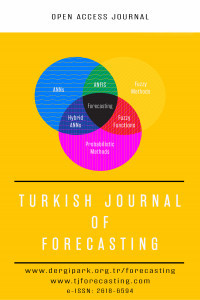Forecasting of Apricot Production of Turkey by Using Box-Jenkins Method
Forecasting of Apricot Production of Turkey by Using Box-Jenkins Method
Apricot production Time Series Analysis, ARIMA, Box-Jenkins, Turkey,
___
- [1] FAO, 2018. Food and Agricultural Organization, http://www.fao.org/faostat/en/#data/PP (Accessed: 27.09.2018) [2] TURKSTAT, 2018. Turkish Statistical Institute, https://biruni.tuik.gov.tr/medas/?kn=92&locale=tr (Accessed: 01.10.2018). [3] İ. Fidan, Economic Analyses of Apricot Production in Igdir Province, Ataturk University, Graduate School of Natural and Applied Sciences, Department of Agricultural Economics, Master Thesis (2009). [4] Y. E. Ertürk, K. Karadaş, M. K. Geçer, Production and Marketing of Apricot in Igdir Province, VII. Bahçe Ürünlerinde Muhafaza ve Pazarlama Sempozyumu, 04-07 October, (2016).pp. 44-49. [5] A. Aslan, The Comparative Economic Analysis of Organic and Conventional Apricot Farms in Malatya Province, Kahramanmaraş Sütçü İmam University, Department of Agricultural Economics, Master Thesis. (2013). [6] O. Gunduz, V. Ceyhan, E. Erol, F. Ozkaraman, An Evaluation of farm Level Sustainability of Apricot Farms in Malatya Province of Turkey, Journal of Food, Agriculture & Environment Vol.9, no, 1, (2011), pp. 700-705. [7] O. Gunduz, Effect of Exchange Rate on Dried Apricot Export in Turkey: A Vector Autoregression (VAR) Analysis, African Journal of Agricultural Research, vol. 5, no, 18, (2010), pp. 2485-2490. [8] O. Gunduz, V. Ceyhan, K. Esengun, Measuring The Technical and Economic Efficiencies of The Dry Apricot Farms in Turkey, Journal of Food, Agriculture & Environment, vol.9, no, 1, (2011), pp. 319-324. [9] M. Karahan, Statistical Demand Forecasting Methods: An Application of Product Demand Forecast With Artificial Neural Networks Method, Selcuk University, PhD thesis, (2011). [10] İ. Dellal, A.A. Koç, An Econometric Analysis of Apricot Supply and Export and Demand in Turkey, Turkey Journal of Agriculture and Forestry, vol. 27, (2003), pp. 313-321. [11] C. Chatfield, “The Analysis of Time Series: An Introduction”, Boca Raton, FL: CRC Press, (2003). [12] G. E. P., Box, G. M., Jenkins, and G. C. Reinsel, “Time Series Analysis: Forecasting and Control”, San Francisco, CA: Holden-Day, (1970). [13] E. Erdogdu, “Natural Gas Demand in Turkey”. Appl. Energy, vol. 87, (2010), pp. 211–219. [14] B. L., Bowerman, T. O. C., Richard, and A. B. Koehler, “Forecasting, Time Series, and Regression: An Applied Approach”. Belmont, CA: Thomson Brooks/Cole, (2005). [15] A., Zaharim, A. M., Razali, T. P., Gim, and K. Sopian, Time Series Analysis of Solar Radiation Data in The Tropics, Euro. J. Sci. Res. 25, (2009), pp. 672–678. [16] D. A., Dickey, W. A. Fuller, “Likelihood Ratio Statistics For Autoregressive Time Series With A Unit Root”, Econometrica, vol. 49, no. 4, (1981), pp. 1057-1072.
- Yayın Aralığı: Yılda 2 Sayı
- Başlangıç: 2017
- Yayıncı: Giresun Üniversitesi
Forecasting of Apricot Production of Turkey by Using Box-Jenkins Method
Bakiye KILIÇ TOPUZ, Mehmet BOZOĞLU, Uğur BAŞER, Nevra ALHAS EROĞLU
Forecasting Chestnut Production and Export of Turkey Using ARIMA Model
Uğur BAŞER, Mehmet BOZOĞLU, Nevra ALHAS EROĞLU, Bakiye KILIÇ TOPUZ
